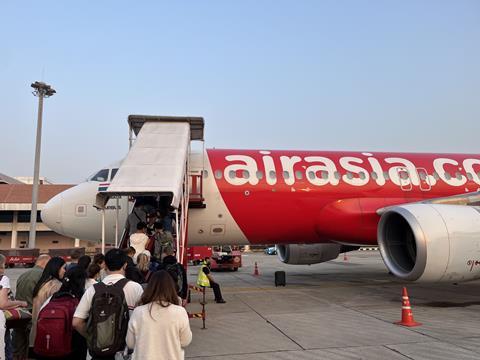Thailand’s continued air travel recovery helped Bangkok Airways and Thai AirAsia post first-quarter operating profits, although costs were challenging during the period.
Bangkok Airways, which focuses on leisure travellers, notes that during the first three months of 2024 tourist arrivals in Thailand were back to 87% of the levels seen before the coronavirus pandemic.

One highlight of the quarter was the launch of two new direct services from the resort island of Koh Samui to the Chinese cities of Chongqing and Chengdu.
Rising travel demand saw the carrier fly 15.5% more seats than in the first quarter a year ago, with the airline attaining 75.6% of its pre-pandemic capacity.
Bangkok Airways saw operating profits nearly double to B2.4 billion ($65 million) in the three months to 31 March from a year earlier. Revenues rose 36.3% to B7.8 billion, as expenses rose 19.9% to B5.4 billion. Net profits more than doubled to B1.9 billion.
Capacity as measured by ASKs rose 16.5% and RPKs rose 18.4%. Passenger load factors improved 1.3 percentage points to 88.4%.
As of 31 March, Bangkok Airways’s cash and cash equivalents stood at B11.7 billion, down 10% from 31 December 2023.

Asia Aviation, the parent company of low-cost carrier Thai AirAsia, also noted the recovery of tourist arrivals in Thailand.
“The number of Chinese tourists continued to accelerate and has now recovered to 56% of 1Q2019 levels,” says Asia Aviation.
“Indian tourists have trended upward, displacing the rank previously held by Japanese tourists, likely affected by the weakest yen in several decades.”
Despite the return of passengers, Thai AirAsia’s operating profit dropped 92% to B83.7 million. Revenues were up 43% to B14 billion, while expenses rose 58% to B13.9 billion.
The carrier notes that costs rose in a number of areas such as fuel (up 56% year on year), staff (up 28%), and MRO (up 75%).
Capacity as measured by ASKs rose 28%, as RPKs rose 31%. Thai AirAsia’s load factor in the first three months of the year rose one percentage point to 93%.
Looking forward, Thai AirAsia expects to grow its fleet to 60 aircraft by the end of the year, up from 56 now.
“With anticipated fare growth [year on year], we expect a 20-23% [year-on-year] increase in revenue from sales and services, while our continued focus on efficiency management is expected to support a turnaround into core profitability”, says Asia Aviation.
“Given this outlook, the management anticipates a notable improvement in the company’s cash flow and financial flexibility.”
Asia Aviation’s cash and cash equivalents stood at B1.6 billon on 31 March, up 26.4% from the beginning of the quarter.


























